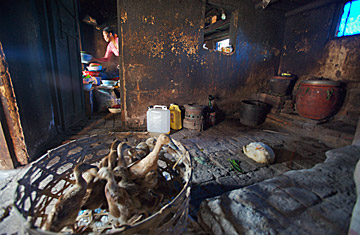
CLOSE QUARTERS: Fowl are kept in the kitchen of a family home in the Balinese village of Munduk Juwet as they await sacrifice in a Hindu ceremony marking six months of an infant's life
Photo Essay: Coming Home to Roost
Sweat beading on his forehead from the mid-morning sun, Hidayat kneels on the stone porch of a dusty house in the Indonesian village of Kemuning, west of Jakarta, where a crowd of curious locals have gathered to see what their government has come to do about what they call flu burung—bird flu. The olive-suited veterinary official sprinkles a fistful of brown coffee beans onto a clean sheet of white paper and begins an improvised lesson in Biostatistics 101.
"Do you have chickens here?" Hidayat asks. A villager named Solichin (like many Indonesians, Hidayat and Solichin go by one name) says that he used to have birds and that they recently died, but he's vague on numbers. "Let's use these beans to say how many chickens you had, and how many died," Hidayat says. "Show me." At Solichin's instructions he counts out around 20 beans, then takes away 19—the kind of death rate that indicates bird flu. "I went to feed them one morning and only one was left," says Solichin. "I think it's flu burung." Hidayat makes a note on the white sheet, and asks what the village did with the dead chickens. Solichin grins—this is an easy question. "We just took them down and threw them in the river."
That's not good, Hidayat tells his audience. If the chickens died of bird flu, they could contaminate the water and further spread the disease. After almost an hour of gentle questioning, the vet nails down the details of past Kemuning outbreaks and explains why sleeping with your chickens—a not uncommon practice in Indonesian villages to protect the birds from thieves—isn't such a great idea. As Hidayat leaves, Solichin says he's pleased with the vet's talk. "It was very helpful, because people here were very confused," he says. Then I ask Solichin if the old cases of bird flu in his village make him worried about a pandemic. He looks at me blankly, cocking his head. "What's a pandemic?"
Indonesia's chickens are about meat and eggs, of course. But they are also a potentially deadly symbol of changing patterns of food production and consumption. While the H5N1 strain of avian flu has occasionally jumped from birds to people for several years now, the fear is that it will mutate and begin spreading easily from person to person, threatening the lives of millions. So a pandemic is why the world cares about dead chickens in a tiny rural village. Though the rare human bird-flu cases have gotten most of the attention, "the most effective way to prevent a pandemic is to stop the virus in animals," says Dr. Bernard Vallat, director general of the World Organization for Animal Health (OIE). In other words: save the chickens, save the world.
Unfortunately, that's exactly what Indonesia can't seem to do. It has already recorded more human deaths from bird flu (79, as of June 6) than any other country, a direct result of its failure to control the virus in poultry. Today, Indonesia is ground zero in the war against bird flu. H5N1 is found in nearly every corner of the sprawling archipelago, and it has become so endemic in poultry that Jakarta no longer bothers to report individual outbreaks to the OIE. While once bird flu-ridden neighbors like Vietnam and Thailand have checked the disease in poultry through firm control measures, Indonesia has seemed virtually helpless. "There doesn't seem to be the official will to deal with this disease," says a senior Japanese diplomat involved in the country's bird-flu aid program. "It's just not there, and we don't know why."